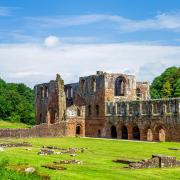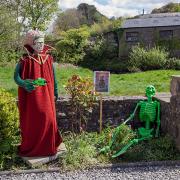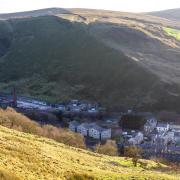This challenging walk from Tockholes to Darwen Tower is sure to blow away the cobwebs
The village of Tockholes, which sits high on the moors above Blackburn and Darwen, appears small when driving along Tockholes Road between Blackburn and Belmont but is actually a lot bigger as a lot of it is spread out down towards Abbey Village and hidden from view.

The name Tockholes derives from Toka’s Hollow and is probably from the time of Danish invasions in the 10th century. It used to have a couple of textile mills and was the base for coal mining up on Darwen Moors. I lived in Tockholes for almost 30 years so am quite familiar with all the paths and tracks in the area so when asked by the Hill Raisers walking group if I knew of a 12 mile walk, I jumped at the chance to introduce them to this beautiful area of the West Pennine Moors.
This walk, over mainly open moorland. offers magnificent views over to the Yorkshire Three Peaks, Pendle Hill, the Bowland Fells, the Lake District, the Fylde Coast and Blackpool Tower, and the Snowdon mountains of North Wales and Anglesey.
1. Leave the car park and bear left and cross the road and go through a gate stile leading into the woods. Join the track and keep left and follow this downhill to eventually reach a path junction. Turn left and go through a gate and head down to Halliwell Bridge but do not cross keep left and follow the track as it climbs uphill.
At the top of the hill keep straight on to a metal gate do not take the left track. Go through the gate and go downhill towards the ruins of Hollinshead Hall but at the foot of the hill take the track going right towards Belmont Road.
Go through a gate and up to the road then turn right and after about 100 metres cross the road to left side and cross a stile then follow the wide grassy path that leads up towards Great Hill. Cross a stile and drop into and out of a small valley then climb the path up the steep flank of Great Hill. The path levels off on top of the hill and head directly for the stone shelter on the summit.
Note: The views from here are particularly good. Twice a year, in early October and late April, it is possible to see the Isle of Man because of the light refraction off the Irish Sea. Looking south west from the summit towards Chorley there is a small round hill on the moors than can easily be picked out. This is Round Loaf and is a Bronze Age burial mound.
2. Take the path going left from the shelter and this turns into a path made of old flagstones. Go downhill and cross a stile then simply keep following the flagstones as they lead over Redmond’s Edge and Spitlers Edge towards Winter Hill and then drop down to a stile that leads onto Rivington Road at Horden Stoops. Join the road at Horden Stoops and turn left and follow the road towards Belmont.

Note: These flags were once the floor of a Lancashire mill.
3. Cross a stile on the left and follow the path downhill and go through a metal gate, then on to a stile crossing a wall into a track. Follow this and go through a stile to the right of a gate and then, as the track forks, take the left fork and follow the track as it turns into a street that leads down to the main road, then turn left and follow the main road.
Cross the road and take a small track on the right down to the reservoir dam. Turn right and cross the dam and once over turn sharp left and follow the road up to Higher Pasture House Farm. Enter the farmyard through a gate then at the house turn right and take the track keeping the house to the right and go through two gates to reach a wide track, then turn left and follow the track.
Keep on the track as it passes under Catherine Edge (after much investigation I cannot find who Catherine was) and passes a large house Lower Pasture Barn on the right. At this point keep straight on do not go left down the house driveway. Cross a stile and carry straight on to reach stile leading onto Tockholes road but do not cross this stile.

Note: Belmont Reservoir was built in 1826 to supply water to Bolton. Belmont at this time was a busy place. A large bleaching works was in the valley at the foot of the village and this was fed with water from a now mostly drained reservoir called Wards Reservoir but more commonly known as the Blue Lagoon. There was also coal mining up on Winter Hill. In the centre of Belmont Reservoir there is an island which is a breeding area for migrating birds and is very noisy in spring.
4. There is a stile on the right, cross this and follow the track as it goes uphill running parallel to the road before dropping down left to a stile leading into the road. Cross the stile and the road and cross a stile and take a path leading down to Hollinshead Hall.
In the grounds of Hollinshead Hall is the famous Wishing Well or Well House to give it its proper name. It is the only complete building on the site but sadly it is now locked due to vandalism but it is possible to look through the window and see inside. I’ll give nothing away here, but it’s worth looking in.

Pass the ruins of the hall and then turn right and follow the path as it goes between two gateposts and climbs uphill to reach a stile leading into Tockholes Road. Join the road and turn left and then cross the road to a stile with a signpost saying Lyons Den. Cross the stile and follow the track as it climbs up the flank of Cartridge Hill.
The hill is like a Swiss cheese below ground as it is riddled with old coal mine tunnels. Depressions on the moor towards Darwen Tower indicate more mining activity but these are the remains of Bell Pits. These were holes or pits dug down into the ground to reach the coal seam then the seam was dug out sideways from the bottom of the pit. The result was a bell shaped chamber, hence the name.
At the top of the hill the track reaches a metal gate go through this but then stop to look back at the view. It really is worth taking time to do this. Carry on along the obvious track that leads all the way to Darwen Tower.
The tower was built in 1898 for Queen Victoria’s Diamond Jubilee hence its other name of Jubilee Tower although I was once asked by a walker from Liverpool to give him directions to the Rocket. A quite apt name given the shape of the tower.

When you’ve taken in the views from the tower, retrace the track and take the second stile on the right and follow the track steeply downhill.
Across the valley is what used to be the main entrance to the coal mines under Cartridge Hill. It is now completely buried but it is possible to trace the track the miners used to reach it.
At the bottom of the hill take the stone steps to reach a major track then turn left and follow the track as it turns right to reach a stile and gate. Cross the stile and follow the obvious track downhill to a stile and gate and cross this and walk back to the visitor centre car park.

Compass points
Start and finish: Tockholes Visitor Centre car park.
Distance: 12.5 miles/20km
Time: 6 hours
Terrain: Mainly good tracks but can be very boggy climbing Great Hill and down from Horden Stoops in or after wet weather. The route is pretty straightforward but care must be taken in mist or low cloud on the moors so a map and compass would be advisable in these conditions.
Facilities: Toilets at Tockholes Visitor Centre.
Map: OS Explorer 287 West Pennine Moors



























